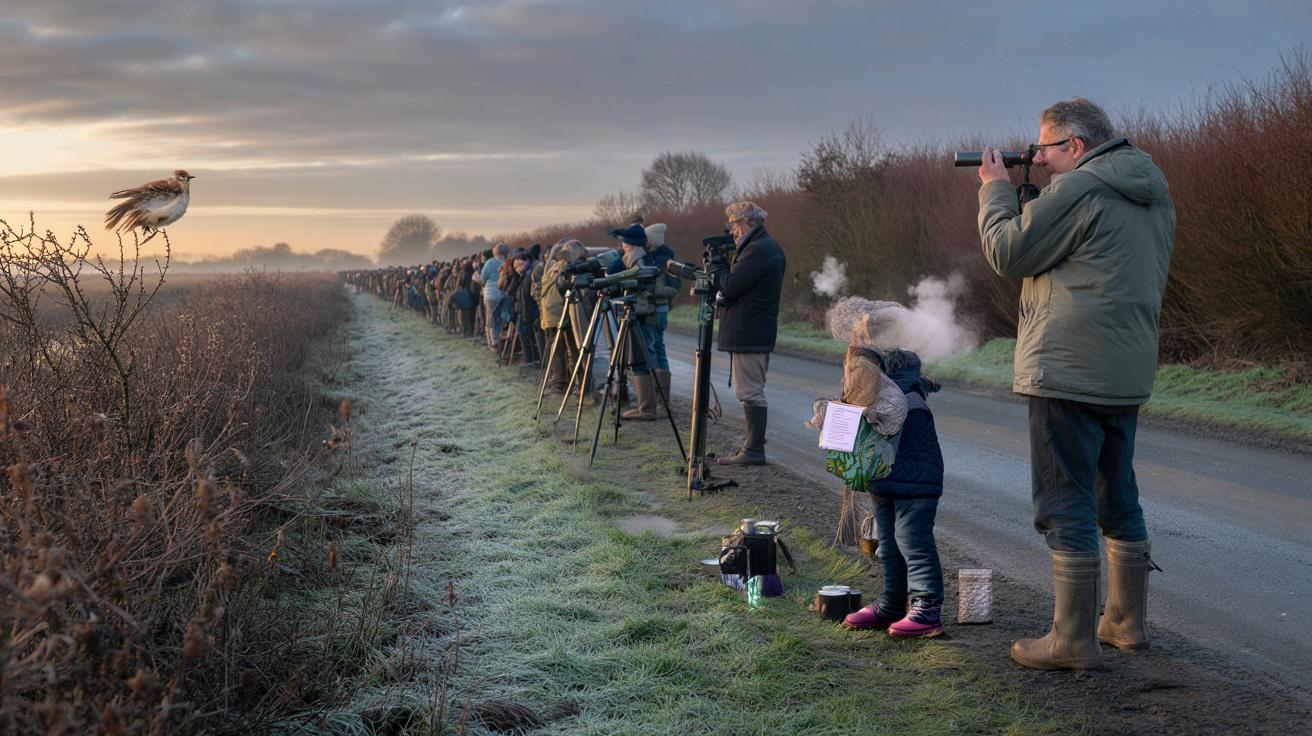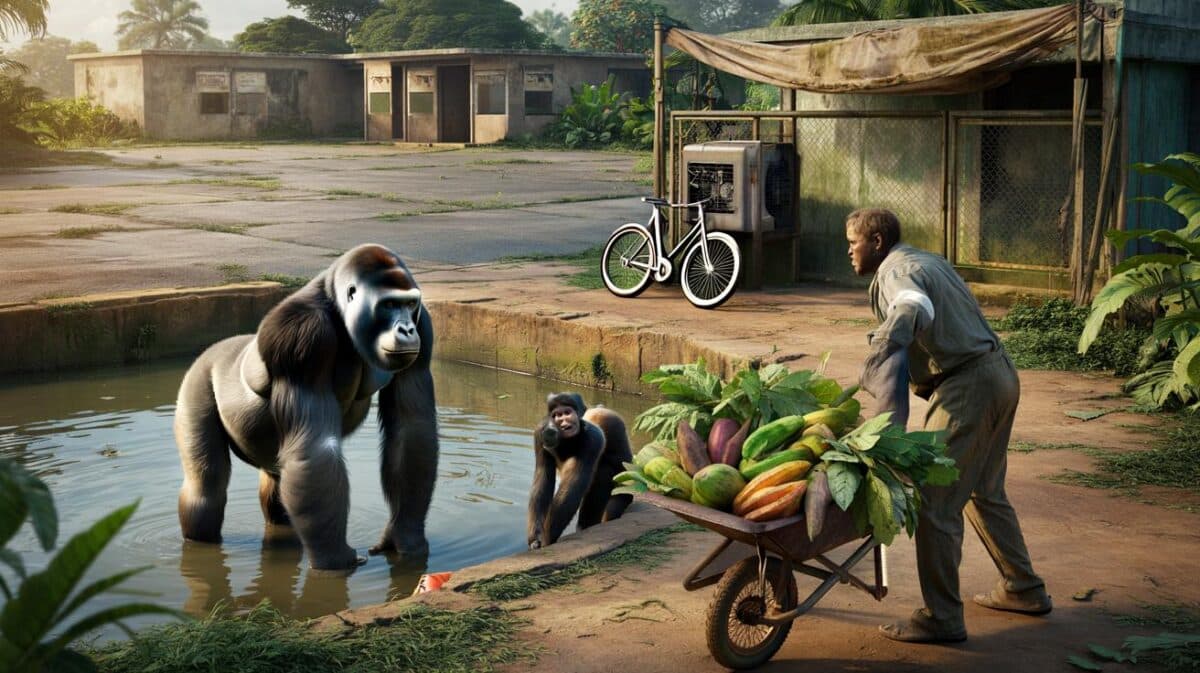Car boots clicked open, tripods sprang up, and the hush of shared attention settled over a muddy lane. Locals say it’s the **first English sighting in 34 years**, and that was all it took to turn a quiet field into a pilgrimage.
The light had that shy, pewter quality you get just after dawn, when breath hangs in the air and every sound feels a notch too loud. A child stood on a parent’s wellies to see over the thistles; a pensioner steadied a telescope with hands that had fixed engines and turned soil. A whisper rippled down the line — “There it is, left of the hawthorn” — and the hedgerow seemed to lean towards itself. We’d all come for a glimpse that might last three seconds. The sun pushed through. The bird flicked its tail, a neat dart of colour against winter-burnt scrub. Then it moved.
A once-in-a-generation visitor
There’s a human thing that happens when a rare bird shows — the ordinary rules of a day slide, and the road fills with people who understand why. You see number plates from three counties away, a van door scuffed by past adventures, a thermos that has seen more dawns than most. One small life with wings becomes the centre of a map. The crowd breathes as one, then breaks into quiet smiles.
A retired lorry driver told me he left at 3am from Leeds, a sleeping bag rolled behind the passenger seat, bacon baps wrapped in foil. A teenager next to him had revision notes peeking out of a coat pocket, eyes bright and unblinking in the cold. Wardens counted more than 300 visitors by midday, a queue that drifted but never swelled into chaos. Someone passed round biscuits, the kind that crumble into your gloves and make you grin anyway.
How do birds end up here after decades away? Weather can knock a migrant clean off its ancient track, wind laying a hand on a wing just long enough to change a story. Jet stream kinks and autumn drift send vagrants thousands of kilometres off course, and a hedgerow in England becomes a brief refuge. Social feeds do the rest: a photo hits a group chat, a grid reference lands, and within hours a muddy lane becomes a stage.
How to witness a rarity without causing harm
There’s a simple craft to seeing well. Arrive early or late to avoid the crush. Park with real care on firm ground, not the verge that looks tempting but hosts a thousand hidden lives. Find the line, pick the end, and ask the last person, “Where’s it showing?” Then hold your spot, lower your voice, and let your eyes do the moving, not your boots.
Be ready for the reality that sightings are brief. The bird will vanish into scrub for long stretches, and you’ll scan branches until your eyes hum. That’s part of the rite. Binoculars beat phones; a borrowed scope beats a selfie. Let’s be honest: nobody actually does that every day. Playback calls and pishing can feel harmless, yet they ramp up stress fast. Keep dogs close, keep feet to paths, and give farmers a thumbs-up when they pass. Gratitude travels.
When in doubt, copy the calmest person there. If their tripod isn’t edging forward, yours doesn’t need to either. If they’re packing up, maybe it’s time for tea. The best days end with nothing flattened, no nest disturbed, and a story everyone can retell with a clear conscience.
« We can host big crowds if people use their heads, » a local warden told me, hands tucked into a battered jacket. « Stand back, keep to the track, and we’ll all go home happy — bird included. »
- What to bring: binoculars, layers, a hot drink, a snack, spare socks, a small torch, and patience.
- What to do: follow wardens’ notes, keep voices low, use the same entry and exit points, pack out rubbish, and leave no trace.
- What to skip: drones, loudspeakers, stepping into crops, blocking gates, parking across farm access, and crowding the bird.
Why this tiny bird has everyone talking
Rarity does a gentle, strange thing to people. It slows them down. Strangers share scopes and swap field notes, and a thousand small kindnesses happen because a scrap of feather and bone decided, for one day, to be here. We’ve all had that moment when you’re sure you saw it, and then doubt creeps in. That uncertainty binds a crowd more than any spectacular view ever could.
There’s another story under the thrill: weather is changing, seasons feel looser, and the routes that birds have followed for millennia are fraying at the edges. A lone visitor isn’t a data set, yet it nudges the conversation. It gets people to care long enough to ask questions about habitat and hedges and the messy margins where life thrives. Maybe that’s why hundreds stood quietly on a cold morning, waiting for a heartbeat of colour to reappear between hawthorn thorns. Maybe it’s why some of them will keep looking, even when the headlines move on.
| Point clé | Détail | Intérêt pour le lecteur |
|---|---|---|
| Rare visitor after 34 years | Once-in-a-generation sighting shared widely by local wardens and birders | Explains the sudden crowds and the buzz |
| How to see it well | Arrive off-peak, keep to paths, follow warden guidance, be patient | Boosts your chances without risking the bird |
| Respect the place | Thoughtful parking, quiet voices, zero disturbance, no litter | Protects wildlife and keeps access open for everyone |
FAQ :
- Where is the bird being seen?On a public lane beside mixed hedgerow and scrub in eastern England; local groups have shared a pin for those travelling.
- What time offers the best chance?Early morning and late afternoon have been the most productive, with the bird feeding low, then perching up briefly.
- How close can I get?Stay on the path and enjoy distant views through binoculars or a scope; crowding reduces sightings and cuts the bird’s feeding time.
- Do I need special gear?Binoculars are enough for a satisfying view; a scope helps if you’re at the back of the line. Warm layers and waterproof boots are wise.
- Is it still there?Vagrants can vanish between checks. Look for fresh updates from local wardens or regional bird news services before setting off.








